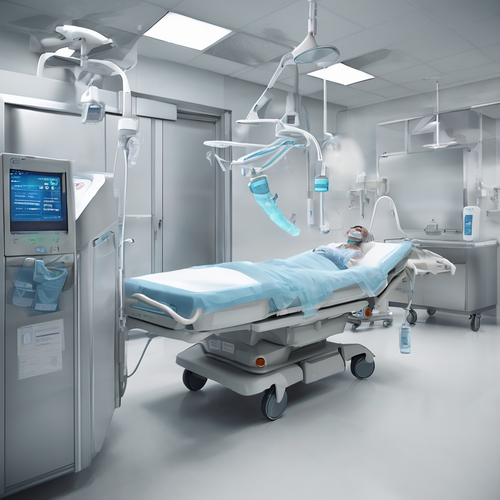Sanitizing Sanctuaries: Effective Disinfection Measures in Hospitals
Imagine entering a thriving ecosystem where the very air whispers secrets of health and safety. While hospitals strive to be such sanctuaries, their delicate balance can shatter like glass under the weight of pathogens. In today’s world, the emphasis on effective disinfection in healthcare settings transcends mere routine; it is a steadfast commitment to patient safety and well-being. Yet, amidst this seriousness, one might ponder: how do we navigate the intricate maze of sanitization without stepping into the murky waters of overkill? 🏥
The Ironic Dance of Cleanliness and Contamination
Humor may be a rare guest in sterile environments, but if there’s irony to be found, it lies in the fact that a place dedicated to healing and health can also be a hotbed for infection. The Centers for Disease Control and Prevention (CDC) estimates that one in every 31 hospital patients has at least one healthcare-associated infection (HAI). In this light, cleaning and disinfection practices emerge as paradoxical heroes—essential and yet consistent underdogs in the fight against invisible foes. ⏳
Understanding the Basics: What Lies Beneath the Surface
Effective disinfection begins with a fundamental understanding of pathogens and how they spread. Bacteria and viruses thrive like weeds, spiraling out of control when subjected to the right conditions—like an unattended hospital room after visitation hours. Hospital surfaces, from waiting room chairs to surgical instruments, harbor these microscopic intruders. It is here that we must engage in the age-old struggle between cleanliness and contamination.
Key Disinfecting Agents:
- Alcohol Solutions: Effective against a broad spectrum of pathogens, alcohol-based disinfectants work like a superhero—a quick strike that evaporates as quickly as it acts.
- Bleach: This powerhouse is like a double-edged sword: potent and effective but harmful if used improperly. Careful mixing and application ensure it does more good than harm.
- Hydrogen Peroxide: This versatile agent acts not only as a disinfectant but as an oxidizing agent that dismantles bacteria’s defenses against your cleaning efforts.
- Quaternary Ammonium Compounds: Often found in household cleaners, these are disinfectants—but when it comes to healthcare settings, the efficacy and application needed can be complex.
Beyond the Surface: Training Staff for Success
However, tools alone can’t navigate the storm. Well-trained staff wield these disinfectants like seasoned warriors. Training protocols should include the proper techniques to ensure the thoroughness of disinfection practices, highlighting the fine line between meticulousness and efficiency. After all, the single most critical step in infection prevention is not the products used, but rather the hands that use them. 🤲
“In healthcare, knowledge is our most potent disinfectant. Whether it’s the proper application of cleaning agents or recognizing high-touch surfaces, education transcends equipment,” observes Dr. Samuel Altman, a renowned infection control expert.
The Disinfecting Protocols: A Symphony of Steps
Implementing a layered approach to cleaning and disinfection can be as intricate as weaving a beautiful tapestry. Each layer is essential to create a unified strategy that is both robust and effective.
- Routine Cleaning: Regularly scheduled cleaning of floors, walls, and surfaces—essential elements of a clean facility—must be integrated seamlessly into hospital routines.
- Terminal Cleaning: This deep-cleaning approach is crucial after a patient is discharged, transforming the room into a pristine environment for the next occupant. It’s akin to ensuring that every inch of a canvas is painted before the gallery opens its doors.
- Enhanced Isolation Measures: Intensive cleaning of isolation areas and the proper disposal of contaminated materials should become second nature, supported by visible signage that leaves no room for ambiguity.
- Monitoring Compliance: Regular audits and observations ensure adherence to cleaning protocols, transforming staff accountability into a culture of excellence.
The Technology Factor: Innovations in Disinfection
As technology dances into the healthcare sector, innovations are revolutionizing disinfection practices. Machines that employ UV-C light offer a glimpse into a future where technology partners with labor, obliterating pathogens on a grand scale. With the uncanny precision of a nightingale serenading the stars, these devices provide an extra layer of reassurance. 🌟
Conclusion: A Culture of Hygiene
Hospital disinfection measures are more than a checklist; they are a tapestry woven into the very fabric of patient care. The actions taken today illuminate the path for tomorrow’s healthcare environments, safeguarding lives as they transition from one patient to the next. In the end, the fight against infection is more than science and reason; it is a tacit acknowledgment of our shared humanity and our collective responsibility to uphold health standards that echo through the ages. 🏥✨
